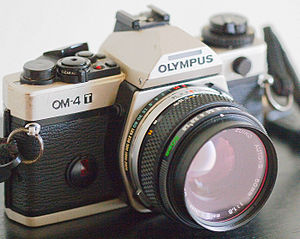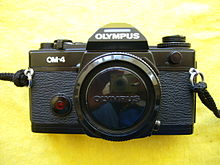This article includes a
list of references,
related reading, or
external links, but its sources remain unclear because it lacks
inline citations. (October 2017) |
 OM-4T | |
| Overview | |
|---|---|
| Maker | Olympus |
| Type | SLR |
| Released | 1983 OM-4; 1987 OM-4Ti (champagne); 1990 OM-4 Ti (black) |
| Production | 1983-1987 OM-4; 1987-2002 OM-4Ti |
| Lens | |
| Lens mount | Olympus OM mount |
| Sensor/medium | |
| Recording medium | 135 film |
| Focusing | |
| Focus | Manual focus |
| Exposure/metering | |
| Exposure | Manual |
| Flash | |
| Flash | Hot shoe |
| Shutter | |
| Frame rate | manually wound |
| Shutter speed range | 1 s – 1/2000 s; Bulb |
| General | |
| Dimensions | 136 × 84 × 50 mm |
| Weight | 540 g (19 oz) (OM-4); 510 g (18 oz) (OM-4Ti) |
| Made in | Japan |
| Chronology | |
| Successor | Olympus OM-4Ti |
The Olympus OM-4 is an interchangeable-lens, 35 mm film, single lens reflex (SLR) camera; manufactured by Olympus Optical Co., Ltd. (today Olympus Corporation) in Japan, and sold as OM-4 from 1983 to 1987 and as OM-4Ti from 1986 to 2002.
History
The OM-4 was the successor to the OM-2N and represented the highest evolution of the Olympus OM-series SLRs (introduced in 1972). Other Olympus OM top models were the OM-1, OM-2, OM-1N, OM-2N, OM-2 Spot Program, OM-3 and OM-3Ti. They all used the same body configuration, but with developing aluminum alloy chassis, electronics, feature levels, and external controls and cosmetics.
Features


The OM-4 used a horizontal cloth focal plane shutter with a manual speed range of one second - 1/2000 second (up to 240 seconds was possible in automatic mode), plus bulb and flash X-sync of 1/60 second. Unlike most SLRs of the era, the OM-4 used a familiar OM-series shutter-speed ring, concentric with the lens mount, instead of a top-mounted shutter speed dial.
The OM-4 accepted all Olympus-made OM bayonet-mount lenses, which were marketed under the Zuiko brand name.
The OM-4 was a battery-dependent (requiring two 1.5-volt silver oxide SR44, V76, 357 cells - use of a 3-volt 1/3N lithium cell is not recommended)[ citation needed] electro-mechanically controlled manual-focus SLR with manual exposure control or aperture-priority auto-exposure.
The OM-4 was the first camera with a built-in multi-spot exposure meter (2% of view; 3.3˚ with 50 mm lens) which could take up to eight spot measurements and average them. Another unique feature was the selectable option to assess the darkest or brightest part of the scene, the camera adjusting the exposure based on that measure. The light meter used a dual-concentric segmented silicon photodiode to provide spot or center-weighted readings. It used a graduated, linear LCD shutter speed display at the bottom of the viewfinder to precisely indicate its readings versus the actual camera settings.
The major improvements of the OM-4 compared to the OM-2N were the stronger chassis, gasket weatherproofing, permanently affixed, dedicated hot shoe and TTL flash cable connector, linear liquid crystal display (LCD) shutter speed display, provision for spot-metering, and flexible integrated-circuit electronics.
Accessories for the OM-4 included all the Olympus motor drives made for the OM-System cameras. Motor Drive 2 was introduced with the OM-4 and, in addition to automatic film advance (up to 5 frames per second), featured motorized film rewind. The camera accepted the Olympus 250-exposure bulk film back (10 meters of film = 250 frames) and the Olympus T-system flashes. The T45 handle-mount electronic flash (guide number 148/45 (feet/meters) at ASA/ISO 100) was also introduced with the OM-4.
The original OM-4 was available in only one color: all black. The introductory US list price for the body only (no lens) was $685. Note that SLRs usually sold for 30 to 40 percent below list price.
The camera dimensions are 87 mm height, 139 mm width, 50 mm depth and 540 grams (19 oz) weight.
Design history
The Olympus OM-series SLRs were influential in SLR design changes in the 1970s and 1980s, with intense competition between the major SLR brands: Olympus, Nikon, Canon, Minolta and Pentax. Between about 1975 and 1985, there was a dramatic shift away from heavy all-metal manual mechanical camera bodies to much more compact bodies with integrated-circuit (IC) electronic automation. In addition, because of rapid advances in electronics, the brands continually leapfrogged each other as they brought out models with new or automated features. The OM-1 introduced the compact body size that inspired similar sized SLRs of competing manufacturers (Pentax M series, Nikon FE/FM). Through-the-lens (TTL) off-the-film (OTF) electronic flash control was pioneered by the OM-2 in 1975.
The OM-4 and its mechanically controlled companion the OM-3 were quite conservative designs, despite their very sophisticated spot-meters. They can be described as the OM-2 and OM-1 with electronic spot-meter controls grafted on. The OM-4's deliberately limited, but tightly focused, features were not intended to appeal to beginners. Instead of offering every possible automated 'bell and whistle', the OM-4's manual spot-metering represented Olympus's intention to provide precision for the professional and advanced amateur photographer.
In 1986, a special ultra-durable version of the OM-4 with champagne-colored titanium top and bottom plates, upgraded electronic circuitry and improved weatherproofing, called the OM-4Ti (OM-4T in the USA), was released, with a US list price of $770.
The OM-4Ti also introduced a new electronic flash-control system. Normally focal-plane shutters are limited in their maximum flash synchronization speed, because of the way they provide fast shutter speeds – timing the second shutter curtain to close more quickly after the first shutter curtain opens. This causes a narrowing of the slit "wiping" the exposure on the film. In effect, a horizontal focal-plane shutter made of cloth is only fully open and usable for flash exposure up to 1/60s. Any faster and a typical one-millisecond flash burst would only partially expose the film - the part open to the slit. The OM-4Ti overcame this problem by having the new Olympus F280 Full Synchro flash pulse its light continuously over 40 milliseconds, long enough to illuminate the slit as it crossed the entire focal plane, even at shutter speeds as fast as 1/2000s. There is, however, a concomitant loss of flash range.
A black-finished version of the OM-4T came out in 1990, listing for $1250 (the natural finished body remained available for $1200).
In the US market the OM-4T was renamed OM-4Ti in 1997 ($1819 list) when the replacement 4T top cover supply became exhausted and it was deemed too expensive for Olympus Japan to create more. The 4Ti had no feature changes over the 4T. The 4Ti was discontinued in 2002.
Olympus failed to make the transition to autofocus (AF) 35 mm SLRs in the wake of the introduction of the landmark Minolta Maxxum 7000 in 1985. Most manual-focus SLRs disappeared by 1989. The OM-4 and OM-3 models were retained because Olympus had no appropriate successors. Their rugged construction also appealed to professional photographers, and some traditionalist amateurs who preferred manual-focus cameras. The Olympus OM-4 sold steadily to Olympus enthusiasts, but more and more slowly over its lifetime, as it became increasingly outdated. It remained in limited production until 2002, when the rise of digital SLRs gave Olympus an opportunity to get back into the SLR camera business with its Four Thirds System. The OM-4 is tough and reliable, and regarded as one of the finest SLRs of its generation.
References
- Anonymous. "Modern Photography's Annual Guide '84: 48 Top Cameras: Olympus OM-4" p 86. Modern Photography, Volume 47, Number 12; December 1983.
- Anonymous. "Modern Tests: Olympus OM-4 Has Multiple Spot, LCD Panel Metering" pp 78–86. Modern Photography, Volume 48, Number 5; May 1984.
- Anonymous. "Annual Guide: Modern Photography's Top Cameras for '87: Olympus OM-4T" p 60. Modern Photography, Volume 50, Number 12; December 1986.
- Anonymous. "Modern Tests: Olympus OM-4T: More Than Just A Titanium Armored SLR" pp 46–50, 78. Modern Photography, Volume 51, Number 6; June 1987.
- Anonymous. "Popular Photography's Annual Guide '92: 35 Top Cameras: Olympus OM-4T" p 86. Popular Photography, Volume 98 Number 12; December 1991
- Anonymous. "Popular Photography: 50 1998 Top 35mm & APS Cameras: Olympus OM-4Ti" p 113. Popular Photography, Volume 61 Number 12; December 1997
- Keppler, Herbert. "Keppler's SLR Notebook: Olympus OM-4T: Improvements, Titanium Body, Sensational Flash" pp 31, 82, 88. Modern Photography, Volume 50, Number 8; August 1986.
- Maitani, Y. and K. Tsunefuuji. "Modern's Inside Your Camera Series #35: Olympus OM-4" pp 78–79, 136, 138, 142. Modern Photography, Volume 48, Number 9; September 1984.
- Matanle, Ivor. Collecting and Using Classic SLRs. First Paperback Edition. New York, NY: Thames and Hudson, 1997. ISBN 0-500-27901-2
- Schneider, Jason. "How The Japanese Camera Took Over" pp 56–57, 78, 86. Modern Photography, Volume 48, Number 7; July 1984.
In popular culture
Olympus OM-4 Ti appeared in the opening title for the movie Licence to Kill.
Olympus OM-4Ti was used by the title character in the 1995 remake of Sabrina (1995 film) with Julia Ormond and Harrison Ford